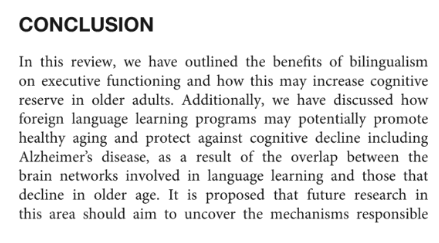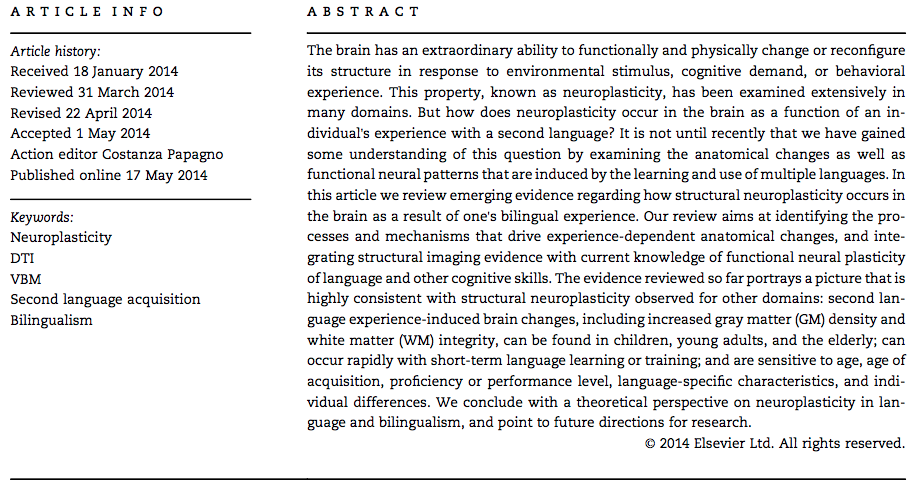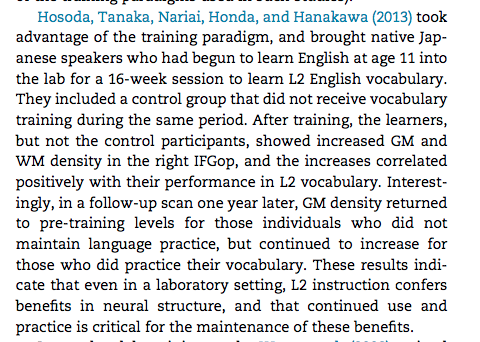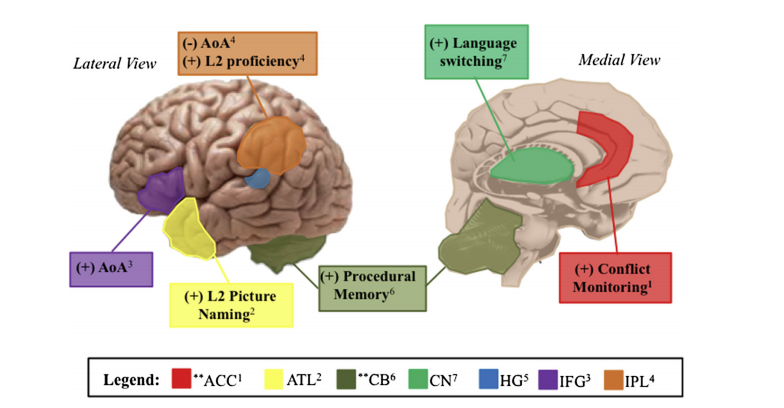Learning a new language makes you smarter (in some specific ways).
While these benefits are not exclusive to learning Japanese, because Japanese grammar is almost perfectly inverted to English grammar it’s likely that the benefits of second language acquisition are maximized.
- Resist the onset of dementia entirely [1]
- Solve whole classes of puzzles more swiftly [1]
- Recognize and adapt to new information and new situations more swiftly [1]
- “A heightened ability to monitor your environment” [1]
- Make more rational decisions [2]
- Improve your English (read: mother tongue) prowess and felicity [2]
- Neuroplasticity (staves off brain aging) [3]
- Increased Brain Gray Matter Density [3, 5]
- Increased Brain White Matter Integrity [3]
- Second language experience induces brain changes that can be found in children, young adults, and the elderly, and can occur rapidly with short-term language training. [3]
- Procedural Memory and Conflict Monitoring (regions of the brain) increased in volume and density. [3]
- Overall better situational awareness. [1, 3, 5]
- Second language learning is a “Good way to keep the brain in shape” [0]
…Second language experience-induced brain changes, including increased gray matter (GM) density and white matter (WM) integrity, can be found in children, young adults, and the elderly; can occur rapidly with short-term language learning or training; and are sensitive to age, age of acquisition, proficiency or performance level, language-specific characteristics, and individual differences. [5]
“Language learning keeps the brain in shape.” 2012 Lund University



Gray Matter Density increases and White Matter Integrity increases thanks to language learning.


In praise of “age-appropriate input” [4]

Hosoda saw that increased gray matter and white matter density was maintained and kept by learners who stuck with language learning over time. Learners who had not kept up with “maintenance” lost the neuroplastic benefits gradually.

Short-burst language training with great frequency increases gray matter density and white matter integrity. For people who stop doing the language training, a year later their levels are back to pre-training levels. If you stick with the training and continue maintenance, the benefits continue to stick around.

bilinguals versus monolinguals. Regions labeled with ** in the legend indicate bilateral GM; otherwise localized in the left
hemisphere or medial section. Further, structural increases in the specific regions are shown to be correlated with
behavioral tasks or variables: (þ): positive correlation with a task or variable; (¡): negative correlation with a task or
variable. These brain-behavior correlations are based on the following studies:
1 Abutalebi et al., (2012); 2 Abutalebi et al., (2014); 3 Klein et al., (2013); 4 Mechelli et al., (2004); 5 Ressel et al., (2012); 6 Pliatsikas et al., (2013); 7 Zou et al., (2012). [From citation 5 below ]

Various research is gathered here from within the last 20 years to show the overall consensus that brain density and volume are positively affected by language learning. Take for example this excerpt that explains how the functional networks each required for different aspects of language are tethered together, resulting in better neural connectivity:




Invest in yourself by studying a new language today!
With over 90 lessons already available and growing every month, Japanese Complete is your ticket to fluent comprehension of Japanese, get a subscription today and begin your path to mastery.

Works Cited
[0] https://www.sciencedaily.com/releases/2012/10/121008082953.htm
[1] “Why Bilinguals Are Smarter” New York Times (US) http://www.cabrillo.edu/~ogarcia/Benefits%20of%20Bilingualism%20-%20NYT.pdf
[2] “Why learn a foreign language? Benefits of bilingualism.” Telegraph (UK) https://www.sandiegounified.org/schools/sites/default/files_link/schools/files/Domain/18742/WORLD%20LANGUAGES%20Benefits%20of%20bilingualismarticle.pdf
[3] (Pushing) the Limits of Neuroplasticity Induced by Adult Language Acquisition https://books.google.com/books?id=EL92DwAAQBAJ&newbks=1&newbks_redir=0&lpg=PA29&dq=language%20learning%20benefits&pg=PA29#v=onepage&q&f=false
[4] https://onlinelibrary.wiley.com/doi/pdf/10.1002/9781118784235.eelt0106
[5] https://sites.psu.edu/kaitlynlitcofsky/files/2017/02/Legault_Cortex_2014-pbpadj.pdf


One thought on “More Japanese = More Brain”